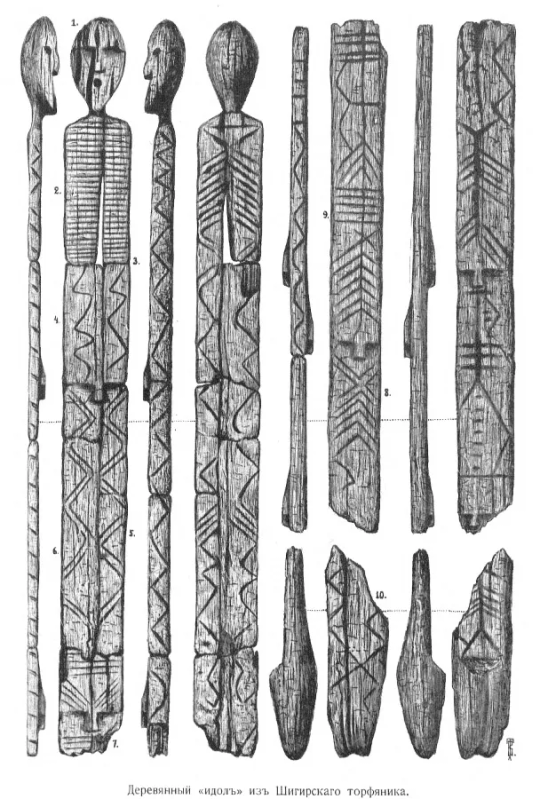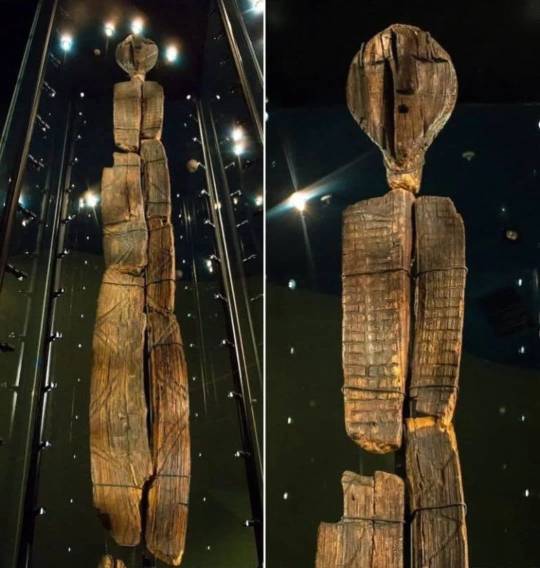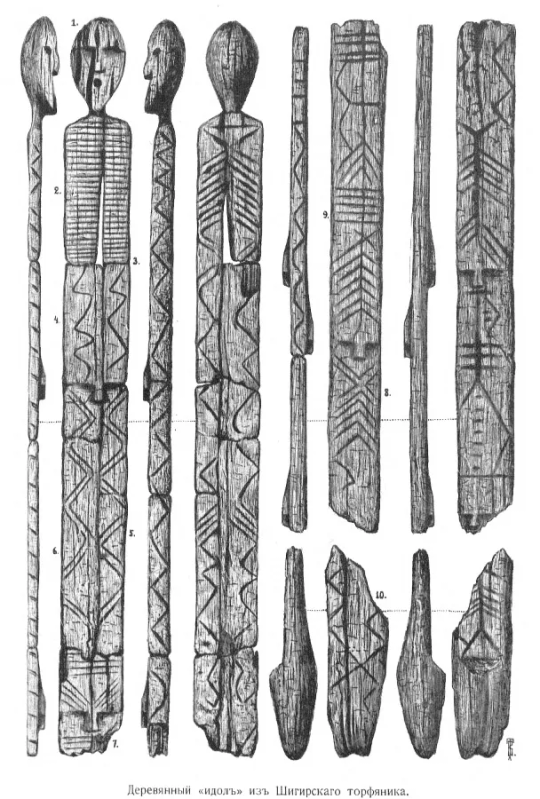#The Shigir Idol
Explore tagged Tumblr posts
Text

#The oldest known wood carved sculpture in the world#the Shigir idol#was carved by Mesolithic hunter-gatherers in today’s Russia some 11000 years ago. Found in 1890#on a depth of 4 meters in a peat bog in Shigir#Middle Urals.#Drawings by: Vladimir Tolmachev
29 notes
·
View notes
Text

The Shigir Idol, discovered in the peat bog of Shigir on the eastern slope of the Middle Urals, near the village of Kalata, is the oldest known wooden sculpture in the world. It was carved during the Mesolithic period, shortly after the end of the last Ice Age, making it twice as old as Egypt's Great Pyramid. The wood it was carved from is approximately 12,000 years old.
The sculpture was discovered on January 24, 1890, at a depth of 4 meters. It was extracted in ten parts and reconstituted to a height of 2.8 meters. Some researchers suggest that the original height of the statue was 5.3 meters. Unfortunately, some of these fragments were lost, so only drawings of them remain.
The initial radiocarbon dating gave an age of around 9,500 years. However, a later German analysis gave an age of 11,500 years, making it the most ancient wooden sculpture of its kind known in the world. In 2021, researchers published the results of a series of recent AMS-results dating the Idol close to the beginning of the Holocene (c. 10,000 cal BC) or about 12,000 years before present.
The Shigir Idol is a nine-foot-tall totem pole composed of ten wooden fragments carved with expressive faces, eyes, and limbs and decorated with geometric patterns. It represents the oldest known surviving work of wooden ritual art in the world. More than a century after its discovery, archaeologists continue to uncover surprises about this astonishing artifact. It is displayed in the Sverdlovsk Regional Museum of Local Lore in Yekaterinburg, Russia.
- Source: Pagan Trader ThePaganTrader.com
#The Shigir Idol#peat bog of Shigir#the Middle Urals#Kalata#wooden sculpture#ancient ways#sacred ways#Ancestors Alive!#Memory & Spirit of Place#Mesolithic period#totem pole#Sverdlovsk Regional Museum of Local Lore#Yekaterinburg#Russia#Pagan Trader#ThePaganTrader.com
11 notes
·
View notes
Text

Discovered in Russia in 1890, the Shigir Idol is one of the oldest known wooden sculptures, dating to approximately 12,000 years ago. It was found in a peat bog, which had preserved it.
The sculpture is 2.8 metres high, but its original height is thought to have been 5 metres or more. It was carved from a larch tree (approximately 159 years old at the time) using the jaws of a beaver and stone tools. On it are faces, hands, and zigzag lines.
It was apparently placed upright next to a lake before it fell into the bog, thus preserving it for over 12,000 years.
According to Thomas Terberger, a scholar of prehistory at Göttingen University in Germany:
“The idol was carved during an era of great climate change, when early forests were spreading across a warmer late glacial to postglacial Eurasia. The landscape changed, and the art—figurative designs and naturalistic animals painted in caves and carved in rock—did, too, perhaps as a way to help people come to grips with the challenging environments they encountered.”
It is currently on display in the Sverdlovsk Regional Museum of Local Lore in Russia.
. . .
Picture Credits: Siberian Times
#siberia#meanwhile in russia#paleolithic#archaeology#shigir idol#holy ground#shamanism#younger dryas
148 notes
·
View notes
Text

Yangelka Culture: this was a unique culture in its own right, with stone tools which were characterised by obliquely blunted points, including some with concave bases, emerging a millennium after the relatively local Shigir Idol people had erected their famous totem pole.
2 notes
·
View notes
Text

Discovered in Russia in 1890, the Shigir Idol is one of the oldest known wooden sculptures, dating to approximately 12,000 years ago. It was found in a peat bog, which had preserved it.
The sculpture is 2.8 metres high, but its original height is thought to have been 5 metres or more. It was carved from a larch tree (approximately 159 years old at the time) using the jaw of a beaver and stone tools. On it are faces, hands, and zigzag lines. No one knows what it was used for, but some say it could have been a territorial or navigational marker, or perhaps it depicts forest spirits or had some ritual purpose. Some have suggested that it depicts a creation myth.
The sculpture might have been placed upright next to an ancient lake before it fell into the bog, thus preserving it for over 12,000 years.
According to Thomas Terberger, a scholar of prehistory at Göttingen University in Germany:
“The idol was carved during an era of great climate change, when early forests were spreading across a warmer late glacial to postglacial Eurasia. The landscape changed, and the art—figurative designs and naturalistic animals painted in caves and carved in rock—did, too, perhaps as a way to help people come to grips with the challenging environments they encountered.”
This sculpture was carved about ten thousand years before the city of London was founded and is over twice the age of Stonehenge. A truly ancient artifact.
It is currently on display in the Sverdlovsk Regional Museum of Local Lore in Russia.
Picture Credits: Siberian Times
5 notes
·
View notes
Text

The Shigir Sculpture is the oldest known wooden sculpture in the world. It was made during the Mesolithic period, shortly after the end of the last Ice Age.
The wood it was carved from is around 11,500 years old.
Its ancient creators carved the work from a single larch tree with 159 growth rings, the authors write in the study.
Gold prospectors first discovered the so-called Shigir Idol at the bottom of a peat bog in Russia’s Ural mountain range in 1890.
The unique object — a nine-foot-tall totem pole composed of ten wooden fragments carved with expressive faces, eyes and limbs and decorated with geometric patterns — represents the oldest known surviving work of wooden ritual art in the world.
25 notes
·
View notes
Text

First attempt at a day scene with the little blue lady. This odd angle mostly resulted from the fact I didn't know what to color the sky.
The tall dudes are based on the Shigir Idol, one of many ancient artifacts I'm obsessed with.
3 notes
·
View notes
Text

The oldest known wood carved sculpture in the world, the Shigir idol, was carved by Mesolithic hunter-gatherers in today’s Russia some 11000 years ago. Found in 1890, on a depth of 4 meters in a peat bog in Shigir, Middle Urals.
Drawings by: Vladimir Tolmachev
208 notes
·
View notes
Text

Discovered in 1890, the Shigir Idol is one of the oldest known wooden sculptures, dating to approximately 12,000 years ago
47 notes
·
View notes
Text
The Shigir Idol
youtube
4 notes
·
View notes
Text
12,100 larch tree wood sculpture years old found in Russia's Ural Mountains
6 notes
·
View notes
Text
Custom Shigir Packaging: Transforming Heritage into Captivating Boxes
The Impact of Custom Shigir Packaging in the Dairy Industry In today’s competitive marketplace, the importance of branding is more critical than ever. Custom carton packaging has become a vital component in the branding strategies of milk producers. Notably, 7 Brothers, a local milk producer inspired by the ancient Shigir Idol, has demonstrated how unique and thoughtfully designed packaging can…
0 notes
Text


The 11,500 year old Shigir Idol, discovered in the peat bog of Shigir in the Middle Ural Mountains near Kalata, Russia.
48 notes
·
View notes
Text
Shigir Idol: World's oldest wood sculpture has mysterious carved faces and once stood 17 feet tall
Live Science By Jennifer NalewickiJune 7, 2024 Name: Shigir Idol What it is: The world’s oldest known wooden sculpture Where it was found: At the bottom of a peat bog in Russia’s Ural Mountains in 1894 When it was made: The towering sculpture was carved 12,100 years ago from the trunk of a larch (Larix) tree, making it more than twice as old as the Egyptian pyramids. Read more…

View On WordPress
0 notes

